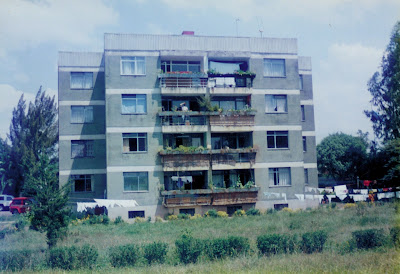I mentioned a while ago
that we spent our first few weeks in Ethiopia living at the SIM Guest House
while we waited for our permanent home to become available. In early May, we
made the move.
Our new home was a
one-bedroom apartment on the third floor of a four story, 16-unit building that
was occupied mostly by Ethiopian families. It would be an understatement to say
that the building was architecturally undistinguished; made of concrete block,
and painted an institutional dingy dark green, it would have fit into any
Communist-bloc urban landscape.
The building was sited
on a large compound with another, identical building adjacent to it, and a
fence around the whole thing. We were high enough to have a bit of a view to
the east, over an unusually large green space that was right outside our
windows. (Google Earth indicates that those two original buildings are still
standing, but the green space has since been filled in with five more apartment
buildings). We were located less than a mile west of Bole International
Airport, and just off Bole Road, the main drag from the airport to the center
of the city.
One fine day, I risked
army ants and waded through the tall grass behind the building to take this
picture of J on the balcony of our apartment:
The apartment itself was small
but perfectly adequate for a married couple with just a few suitcases full of
belongings. The front door led into a short hallway with the bathroom
immediately to the right; the hallway opened up into the main living area with a wall of windows. The kitchen and dining area were around the corner to the right,
behind the bathroom, and the bedroom was just off the living room. It was
basic, with yellow walls and tile floors throughout, and kind of scary gross
cabinets in the kitchen area.
Though FH/E was able to
provide us with some household necessities, we had to purchase many of our own
furnishings, which was its own adventure. Furniture could be acquired from a
local maker in the Piazza area of town. It was literally custom made for us,
and we had to work hard to convince the dealer that we only required one sofa
and two armchairs – half the amount of furniture in a typical Ethiopian living room.
Imported appliances had to be bought from a government store, with US currency,
and we had to have a permit and dollars in hand just to get in the door. We
bought a “geyser” (water heater), a small refrigerator, and a dual-fuel range,
with electric burners and a gas oven that used liquid propane. At another
government store, open only to foreigners, we used more of our dollars to
purchase imported kitchen supplies. We had brought sheets, a down comforter, and a
gingham tablecloth from home, which we used as a makeshift curtain on our bedroom
window. Our dining table and chairs, a rickety desk, and our bed (I think) were
provided by FH/E, along with some dishes and a large water filter.
So, yeah – you couldn’t
drink the water. I mean, you could –
the city water was chemically treated, but it wasn’t recommended for foreigners
to drink it straight from the tap. Best case, you could suffer some, uh,
intestinal distress; worst case, you risked acquiring a serious water-borne
illness like typhoid or cholera. The SIM Guest House had an industrial scale
treatment system that used ultraviolet light to kill the microscopic bugs in the gallons of
water they used every day. At home, we and most of the people we knew had a
table top Katadyn filter system just like this one: pour tap water into the upper container and use
fancy filtered water from the spigot below. At about $250 each, these filters
are (and were) expensive, so it was a relief that we didn’t have to purchase one
for ourselves. We did have to make an effort to keep our mouths closed during
showers, and we had to carry water to the bathroom sink to brush our teeth. But
at least we had water – running water,
hot water, and usually enough water pressure for two showers in the morning – so it
could have been far worse. Even (especially) in the city, we wouldn’t have had
to go very far to find hundreds or thousands of people for whom access to
clean water and sanitary facilities was a luxury.
What we didn’t have was
a telephone. The government owned the telecommunications service as well as
every individual telephone, and demand was far greater than the existing
infrastructure could support. Rumor had it that there were 10,000 households waiting for
service, so the best (only) way to get a telephone in those days before mobile
phones were common was to move into a house that already had one. Without a telephone, living
in a building with no other English speakers, it wasn't long before we found ourselves feeling rather isolated.

No comments:
Post a Comment